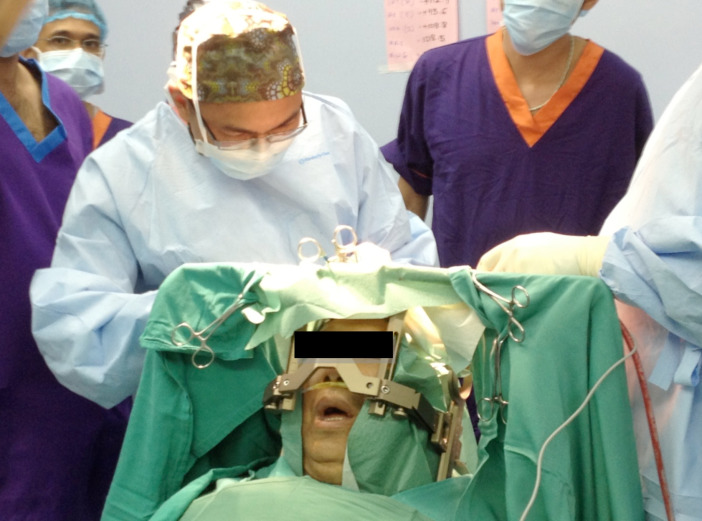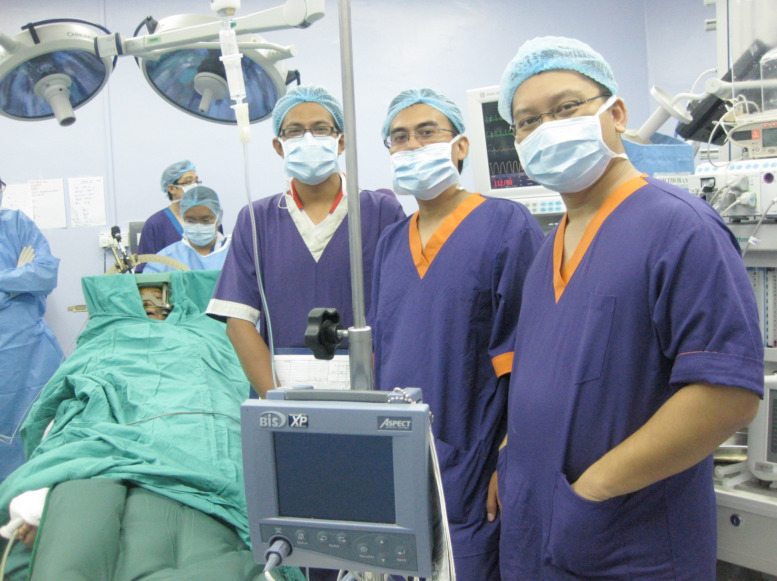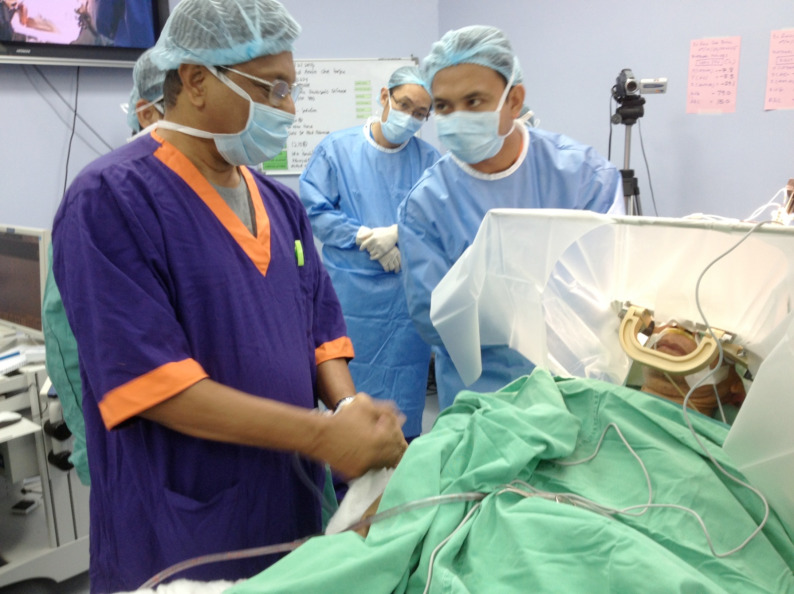Abstract
Awake craniotomy is a brain surgery performed on awake patients and is indicated for certain intracranial pathologies. These include procedures that require an awake patient for electrocorticographic mapping or precise electrophysiological recordings, resection of lesions located close to or in the motor and speech of the brain, or minor intracranial procedures that aim to avoid general anaesthesia for faster recovery and earlier discharge. This type of brain surgery is quite new and has only recently begun to be performed in a few neurosurgical centres in Malaysia. The success of the surgery requires exceptional teamwork from the neurosurgeon, neuroanaesthesiologist, and neurologist. The aim of this article is to briefly describe the history of awake craniotomy procedures at our institution.
Keywords: awake craniotomy, electrocorticographic mapping, electrophysiological recording
Introduction
Awake craniotomy is indicated when a patient’s cooperation is needed and anaesthetic effects are minimised during the neurosurgical procedures. The indications have been classified into four broad categories. The first is functional surgery that requires electrocorticographic mapping and accurate electrophysiological recordings such as during epilepsy surgery and deep brain stimulation (DBS) for Parkinson’s disease. The second category includes the resection of lesions that are located close to or in the motor and speech of the brain. The third category is the obliteration or resection of vascular lesions that supply essential functional territories. The fourth category includes minor intracranial procedures that have no functional goal, for example, ventriculostomy, stereotactic biopsy, brain endoscopy, and resection of small brain lesions (). The success of the surgery requires careful patient selection and meticulous preparation from all team members involved.
History
Early in its history, awake craniotomy was used for the treatment of epilepsy. Archaeological records indicate that during ancient times, thousands of years ago, patients were treated for seizures by trepanation of the skull. This procedure was successfully practiced long before the advent of general anaesthesia. The modern era of awake craniotomies began in the late 1920s, when Wilder Penfield was attempting to treat patients who had intractable epilepsy. Wilder Penfield and Andre Pasquet published their landmark paper on the surgical and anaesthetic aspects of surgery after administration of local anaesthesia and intermittent sedation and analgesia. His technique was reproducible and often successful and became an accepted surgical technique worldwide for the treatment of epilepsy. In addition, he applied the technique of awake craniotomy to some patients who had brain tumours (2,3).
Anaesthesia management is very important for the success of awake craniotomy. There are two main anaesthesia techniques that are used for awake craniotomy. The most frequent technique is monitored conscious sedation, and the other option is the asleep-awake-asleep technique. Analgesia can be provided either by intravenous (IV) analgesia, local anaesthesia, or scalp block. The goals of anaesthetic management are to allow the patient’s cooperation, to preserve general homeostasis, and to limit the interference between anaesthetic agents and the quality of electrophysiological recordings (1). One of the first large studies that described the anaesthetic experience with awake craniotomy was published by Archer et al. in 1988. Those authors used local analgesia, IV fentanyl, and IV droperidol in 354 cases of awake craniotomy for epilepsy surgery (4).
The practice of awake craniotomy has been used in North America since the 1980s, before its use spread to Europe. The practice has also recently spread to Asia. In the late 1990s, several case reports of awake craniotomy were published in Asia, although most of them were reported in the local neurosurgery journals. There were reported cases of awake craniotomy from Japan, India, and Thailand. China and Indonesia also introduced awake craniotomy surgery in 2003 and 2007, respectively (2). In Malaysia, Hospital Universiti Sains Malaysia (HUSM), as one of the leading neurosurgical centres in the country, performed its first awake craniotomy surgery for DBS surgery in a Parkinson’s disease patient on 22nd March 2007. The first surgery was successfully performed by our neurosurgical team, which was led by Professor Dr Jafri Malin Abdullah, Dr Abdul Rahman Izaini Ghani, and Associate Professor Dr Zamzuri Idris. Dr Sarun Nunta-aree, a neurosurgeon from Siriraj Hospital, Bangkok, was also invited to supervise our procedures. Figure 1 showed Dr Abdul Rahman Izaini Ghani performing one of awake craniotomies for DBS surgery. The anaesthesia team was led by Dr Wan Mohd Nazaruddin Wan Hassan (Figure 2), and the neurology team was led by Professor Dr John Tarakan and Dr Shalini Bhaskar. A neurologist was involved intraoperatively for neurological assessment during electrophysiological recordings and stimulation as shown in Figure 3. The first type of anaesthesia management we used for DBS was a monitored anaesthesia care technique consisting of a combination of IV propofol, IV midazolam, and IV fentanyl. Local anaesthesia with lignocaine 2% was applied over the scalp before the skin incision. This surgery was among the earliest DBS procedures performed for a Parkinson’s disease patient in Malaysia. At the time of this report, there have been a total of 11 cases of awake craniotomy for DBS surgeries that were successfully performed in our institution. Other than Parkinson’s disease, the procedure has also been performed for patients who have movement disorders such as Tourette syndrome and dystonia. We reported intracerebral haematoma as a complication after DBS surgery in our first case of awake craniotomy for Tourette syndrome (5). The awake craniotomy for DBS surgery is less invasive than awake craniotomy for tumor excision because it requires only bilateral burr holes for the insertion of electrodes and is followed by general anaesthesia at the end of the surgery for the insertion of a pulse generator over the subscapular area.
Figure 1:
Dr Abdul Rahman Izaini Ghani performing deep brain stimulation (DBS) surgery.
Figure 2:
Dr Wan Mohd Nazaruddin (centre) with his anaesthesia team.
Figure 3:
Professor Dr John Tarakan performing neurological assessment of a deep brain stimulation (DBS) patient.
On 23rd May 2011, we began more invasive awake craniotomy surgery for the excision of tumours. This first case was surgery on a 35-year-old housewife who had a brain tumour close to her eloquent area. The surgery was conducted by Associate Professor Dr Zamzuri Idris, and the anaesthesia team was led by Dr Wan Mohd Nazaruddin Wan Hassan. Figure 4 showed Associate Professor Dr Zamzuri Idris was performing one of our awake craniotomies for tumor excision. The anaesthesia technique used was a combination of monitored conscious sedation with IV dexmedetomidine and targetcontrolled infusion (TCI) of remifentanil. Analgesia was provided by scalp block at six sites of scalp innervations. To date, we have successfully performed four cases of awake craniotomy for tumour excision using the same anaesthesia technique (6). The fifth case of tumour excision had to be transferred to general anaesthesia because the patient developed acute generalised tonic clonic seizures during electrocorticographic mapping.
Figure 4:
Associate Professor Dr Zamzuri Idris performing awake craniotomy for tumour excision.
The success of awake craniotomy surgery is another great achievement for the Department of Neurosciences of HUSM as a result of excellent teamwork between multi-disciplinary departments particularly neurosurgery, anaesthesiology, and neurology. As far as we know, HUSM has performed the greatest number of awake craniotomies in Malaysia to date, mainly for DBS surgery and the excision of brain tumours. In the future, we hope to expand the use of awake craniotomy surgery to other indications, for example, for epilepsy surgery and other nonfunctional neurosurgery.
Acknowledgments
I would like to thank Professor Dr Jafri Malin Abdullah for the idea and advice in writing this article.
Footnotes
Conflict of interest
None.
Funds
None.
References
- 1.Bonhomme V, Franssen C, Hans P. Awake craniotomy. Eur J Anaesthesiol. 2009;26(11):906–912. doi: 10.1097/EJA.0b013e32833000c5. doi: 10.1097/EJA.0b013e32833000c5 . [DOI] [PubMed] [Google Scholar]
- 2.July J, Manninen P, Lai J, Yao, Bernstein M. The history of awake craniotomy for brain tumor and its spread into Asia. Surg Neurol. 2009;71(51):621–624. doi: 10.1016/j.surneu.2007.12.022. doi: 10.1016/j.surneu.2007.12.022 . [DOI] [PubMed] [Google Scholar]
- 3.Bulsara KR, Johnson J, Villavicencio AT. Improvements in brain tumor surgery: the modern history of awake craniotomies. Neurosurg Focus. 2005;18(4):e5. doi: 10.3171/foc.2005.18.4.6. [DOI] [PubMed] [Google Scholar]
- 4.Archer DP, McKenna JMA, Morin L, Ravussin P. Conscious sedation analgesia during craniotomy for intractable epilepsy: a review of 354 consecutives cases. Can J Anaesth. 1988;35(4):338–344. doi: 10.1007/BF03010852. [DOI] [PubMed] [Google Scholar]
- 5.Idris Z, Ghani ARI, Mar W, Bhaskar S, Wan Hassan WN, Tharakan J, et al. Intracerebral haematomas after deep brain stimulation surgery in a patient with Tourette syndrome and low factor XIIIA activity. J ClinNeurosci. 2010;17(10):1343–1344. doi: 10.1016/j.jocn.2010.01.054. doi: 10.1016/j.jocn.2010.01.054 . [DOI] [PubMed] [Google Scholar]
- 6.Mohd Nazaruddin WH, Mohd Fahmi L, Laila AM, Zamzuri I, Abdul Rahman IZ, Hardy MZ. Awake craniotomy: A case series of anaestheticmanagement using a combination of scalp block, dexmedetomidine and remifentanil in Hospital Universiti Sains Malaysia. Med J Malaysia. 2013;68(1):64–66. [PubMed] [Google Scholar]






